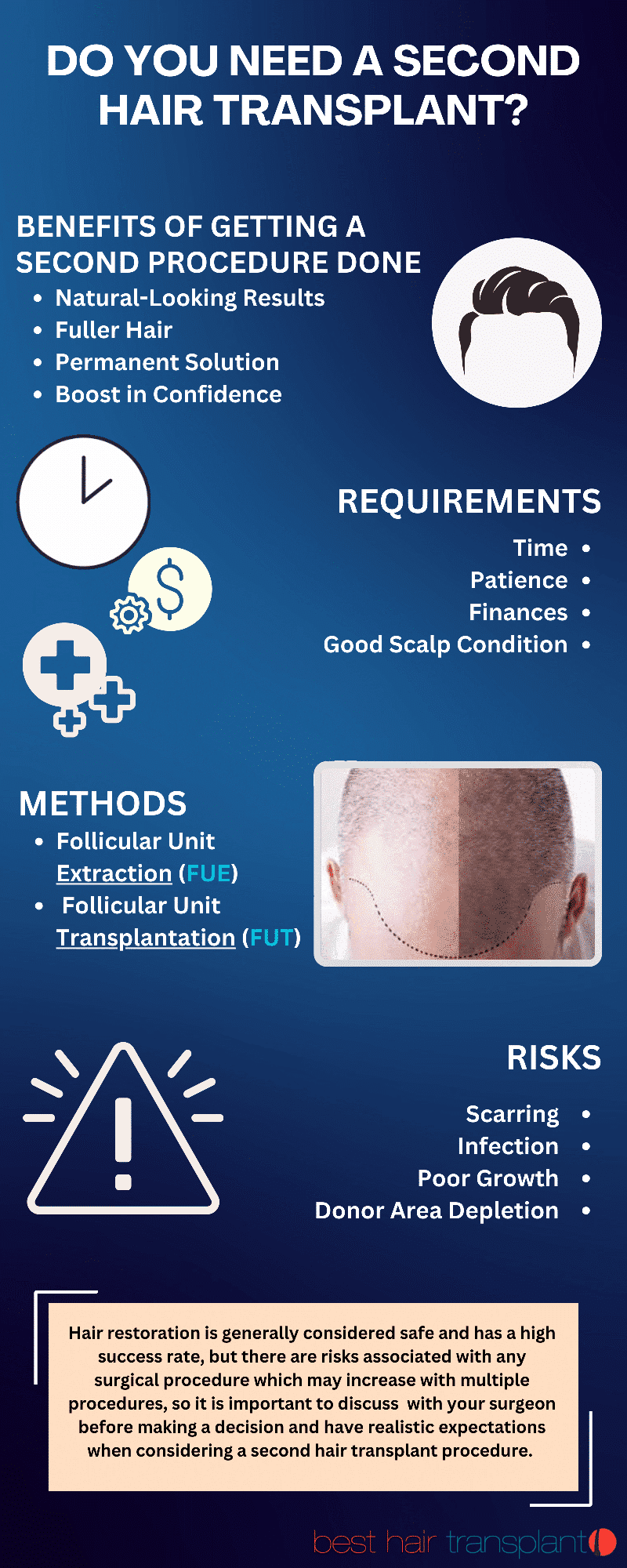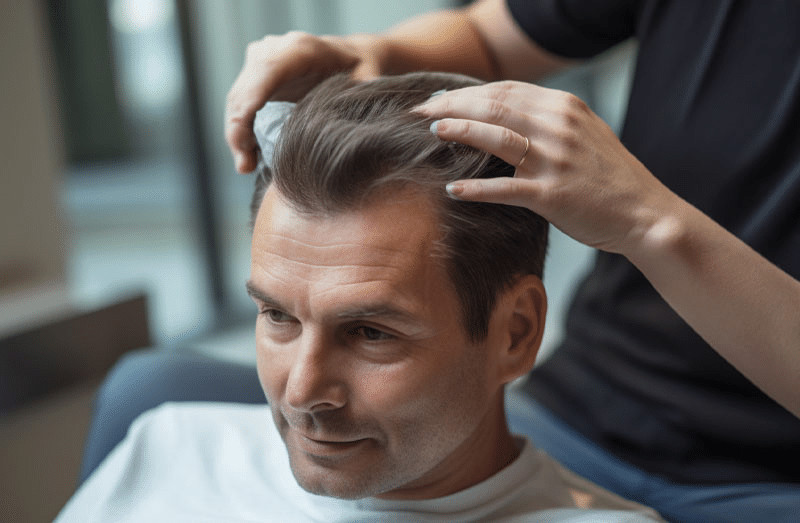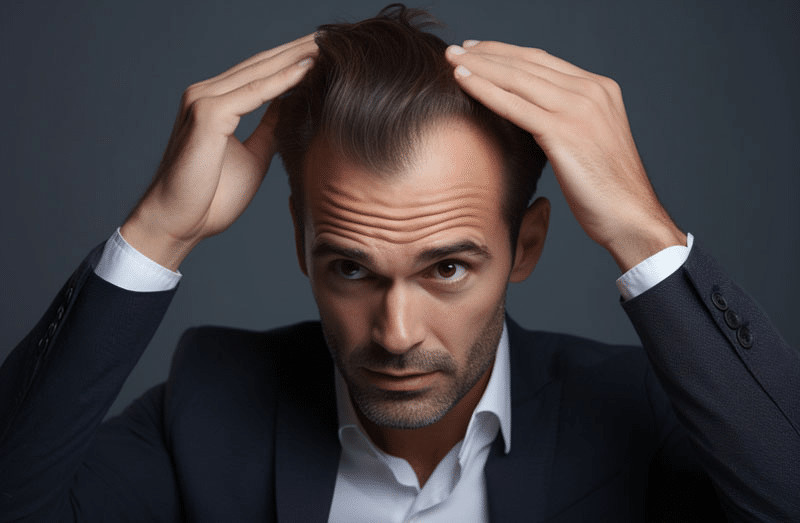If you have undergone a hair transplant procedure, the results can be truly life-changing. But what happens when your hair loss continues to progress after the initial surgery? This is where the question of needing a second hair transplant arises.
A second hair transplant may be necessary if you are not completely satisfied with the coverage and density achieved from the first procedure. This could also be due to natural hair loss progression or other factors like scarring from the initial surgery.
In this article, we will explore the reasons for needing a second hair transplant and what you can expect from the procedure. We will also discuss some common myths and misconceptions surrounding second hair transplants.

An Overview of Hair Transplants – What They Are and How They Work
First, it is important to understand what a hair transplant actually entails. A hair transplant is a surgical procedure in which hair follicles are extracted from one area of the scalp (usually the back or sides of the head where hair is more resistant to balding) by another hair transplant, and transplanted into areas of thinning or baldness. This process allows for new, healthy hair growth in previously sparse areas.
There are two main types of hair transplants: Follicular Unit Transplantation (FUT) and Follicular Unit Extraction (FUE). FUT involves removing a strip of scalp tissue containing donor hairs and dissecting it into smaller hair grafts used for transplantation.
FUE, on the other hand, involves individually extracting individual follicular units directly from the scalp and transplanting them into the desired area. Both methods can yield successful results, and the chosen technique will depend on each patient’s individual needs.
The Benefits of Hair Transplant Surgery and Why People Choose It

Hair transplant surgery has become a popular choice for individuals looking to restore their hairline and improve their overall appearance. Some of the main benefits of hair transplant surgery include:
Natural-looking results: With advances in technology and techniques, modern hair transplants can create natural-looking results that blend seamlessly with your existing hair.
Permanent solution: Unlike temporary solutions such as wigs or hairpieces, a hair transplant offers a permanent solution to hair loss. This means you won’t have to worry about constantly maintaining or replacing any cover-ups.
Boost in confidence: Hair loss can be a major source of insecurity for many people. By restoring your hairline, a hair transplant can help boost self-esteem and confidence.

Factors to Consider Before Getting a Second Hair Transplant
While a hair transplant can be a life-changing procedure, there are factors to consider before deciding on two hair transplants or a second one. These include:
Time and patience: A second hair transplant will require time for recovery and regrowth, just like the first one. It is important to have realistic expectations and be patient with the process.
Finances: Hair transplants can be expensive, so it is crucial to assess your financial situation before committing to additional procedures.
Scalp condition: The health of your scalp and donor area plays a significant role in the success of a hair transplant. If you have any underlying conditions or scarring from the previous procedure, it may affect your eligibility for a second transplant.

You May Need Two Hair Transplant Sessions
As mentioned, it is not uncommon for individuals to require multiple hair transplants in order to achieve their desired results. This may be due to a variety of reasons, such as the extent of hair loss, the texture of their natural hair, or financial constraints. However, if you are considering a second hair transplant, it is important to discuss your goals and expectations for hair surgery with your surgeon beforehand.
While a second procedure may seem daunting, it can ultimately lead to more satisfactory results and help you achieve your desired appearance. Just be sure to carefully consider all factors before making a decision and consult with an experienced surgeon who can guide you through the process.
With proper planning and realistic expectations, a second hair transplant can provide you with long-lasting results and restore both your hairline and confidence. Overall, a hair transplant can be a life-changing procedure for those struggling with hair loss, and understanding the process and potential outcomes is crucial in making an informed decision.
So if you’re considering a second hair transplant surgery, be sure to thoroughly research your options and consult with a trusted surgeon to find the best solution for you.

Methods for Your Second Hair Transplant Operation
As mentioned, there are two primary methods of hair transplantation that can be used for hair transplant patients for a second or even third procedure. These include:
Follicular Unit Transplantation (FUT): This method involves removing a small strip of skin and hair from the back of the scalp and transplanting it into the desired area. It leaves behind horizontal scars that can be disguised by surrounding hair.
Follicular Unit Extraction (FUE): In this method, individual follicular units are extracted directly from the scalp and transplanted into the desired area. It leaves behind tiny circular scars that are easily concealed.
The best way to determine if a second or third full hair transplant operation is the right course of action for you is to schedule a complimentary consultation. You can schedule a consultation on our website at your convenience. During your consultation, we can discuss your past history with hair transplantation and decide the most appropriate treatment plan moving forward.
If you’re new to Best Hair Transplant and you’re looking for a second hair transplant procedure, welcome! If you’re already one of our loyal patients, we’re excited that you’re ready to finish crafting your fabulous new look and to be a part of your hair restoration journey.

Risks Associated With Multiple Hair Transplant Procedures
While hair restoration surgery is generally considered safe and has a high success rate, there are always risks associated with any surgical procedure. These risks may increase with multiple procedures, so it is important to discuss them with your surgeon before making a decision. Some possible risks for hair transplant surgeons include:
Scarring: As mentioned, both FUT and FUE techniques can leave behind scars. While these can typically be hidden by surrounding hair, they may become more noticeable with multiple procedures.
Infection: Anytime the skin is cut or punctured, there is a risk of infection. This risk may increase with repeated surgeries.
Poor growth: In some cases, the transplanted hairs may not grow as well as expected in the desired area. This may be due to a variety of factors such as poor blood supply or underlying medical conditions.
Donor area depletion: The donor area may become depleted with repeated surgeries, making it more difficult to harvest hair for future procedures. This is a concern, especially for individuals with extensive hair loss.

Understanding The Results Of A Second Hair Transplant Procedure
It is important to have realistic expectations when considering a second hair transplant procedure. While the goal of hair transplant clinic is to achieve a fuller and more natural-looking head of hair, it may not be possible to completely restore all areas affected by hair loss. Additionally, depending on the cause of your hair loss, new hairs may continue to thin over time, requiring additional procedures.
During your consultation with a qualified surgeon, they will assess your individual case and discuss the potential outcomes of a first transplant and a second procedure. This will include discussing the number of grafts needed, the expected density in the recipient area, and any limitations that may affect the final results.
Additionally, it is important to note that results may vary from person to person. Factors such as age, health condition, and type of hair loss can all play a role in the final outcome failed hair transplant. It is important to have open communication with your surgeon and to follow their post-operative instructions carefully in order to achieve the best results possible.

Tips For Making The Most Out Of A Second Hair Transplant Procedure
Choose a qualified and experienced surgeon: When considering a second hair transplant, it is crucial to choose a skilled and experienced surgeon who specializes in FUE hair transplant This will ensure that you receive the best possible results and minimize the risk of complications.
Follow post-operative instructions: Following your surgeon’s post-operative instructions carefully can greatly impact the success of your procedure. This may include avoiding certain activities, taking prescribed medication, and keeping the scalp clean.
Be patient: Hair transplant procedures take time to show full results. It is important to be patient and allow for proper healing before expecting to see significant growth. Results can also vary from person to person, so it is important to have realistic expectations.
Take care of your transplanted hair: After your procedure, it is important to take care of your newly transplanted hair to ensure its growth and health. This may include using special shampoos or treatments recommended by your surgeon.
Consider complementary treatments: Depending on the cause of your hair loss, your surgeon may recommend additional complementary treatments such as medication or laser therapy to help maintain and improve the results of your second hair transplant.

FAQS
What is a second hair transplant, and when is it typically considered by individuals seeking hair restoration?
A second hair transplant, often referred to as a follow-up or additional hair transplant, is a procedure performed after a previous hair transplant session. It is considered by individuals who have already undergone a hair transplant but desire further hair restoration or wish to address areas not adequately covered in the initial session.
How does a second hair transplant session differ from the first?
A second hair transplant session is similar in many ways to the first hair transplant, involving the extraction of donor hair and transplantation into the recipient area.
However, it may require different techniques or considerations, such as managing scarring from the initial procedure or working around existing transplanted hair. Patients should carefully discuss their goals and expectations with their surgeon to plan a successful follow-up session.
How many hair transplants are typically required to achieve the desired hair restoration results?
The number of hair transplants required varies from person to person and depends on factors like the extent of hair loss and the desired level of density.
While some individuals achieve their desired results with a single hair transplant, others may opt for a second session to further improve hair density or address specific areas. A second hair transplant is relatively common in the hair restoration journey.
What can patients expect in terms of recovery and results after a second hair transplant?
Recovery and results after a second hair transplant are similar to those of the first procedure. Patients can expect some initial redness and swelling, but these typically subside within a few weeks. The final outcome may take several months to become fully visible as the transplanted hair gradually grows and matures.
